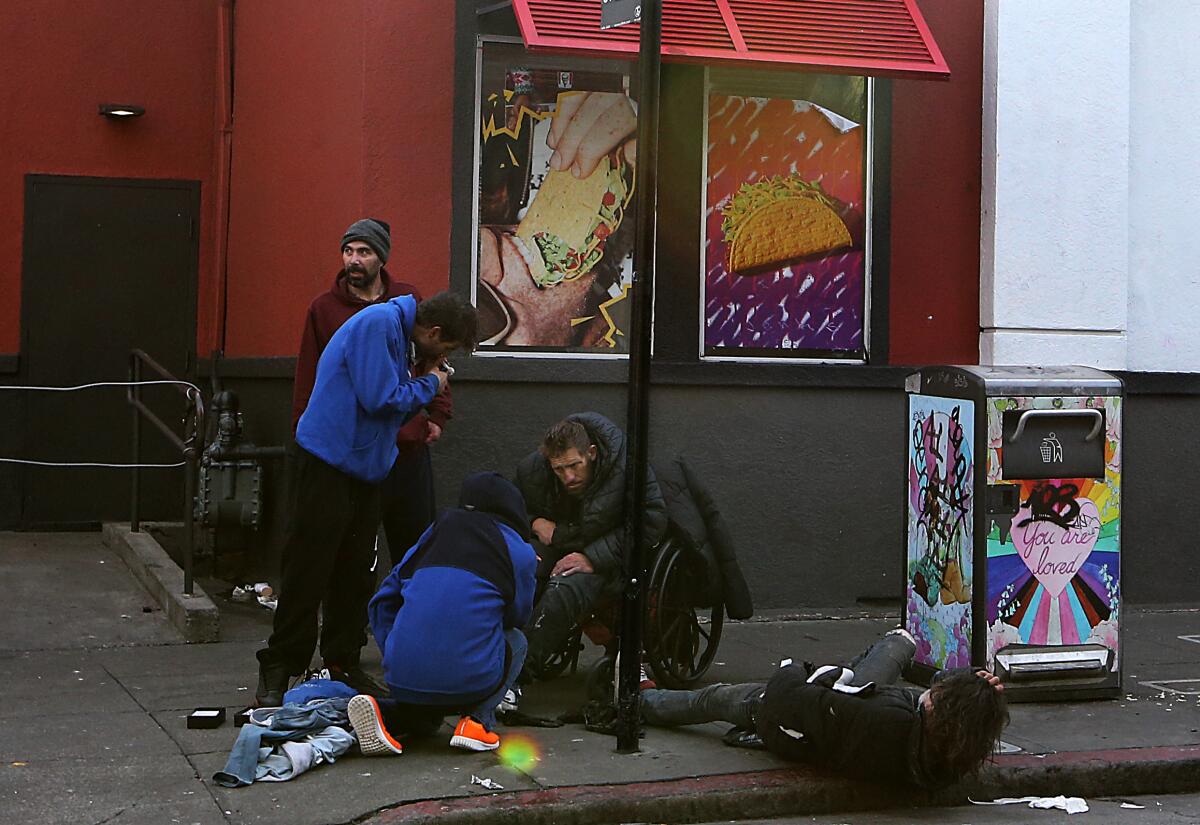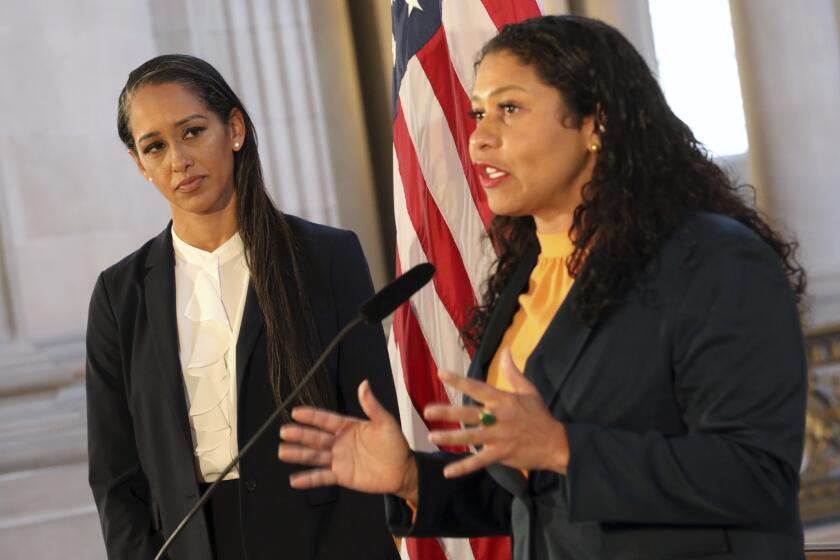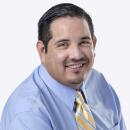Nearly half of San Francisco drug users are visitors, fueling debate on aid to poor and addicted

- Share via
Nearly half of the individuals cited for drug usage in San Francisco over a 12-month period ending in February were not residents of the city, according to a report released Thursday that sparked a debate over how to care for poor and drug-addicted people in one of the nation’s most progressive cities.
That data led to speculation from the mayor’s office and allies that abuse of free money offered to low-income residents was driving substance abusers to the Bay Area. But San Francisco Board of Supervisors President Aaron Peskin called the statistics released by the office of Mayor London Breed “highly suspect” and said the report was a cynical attempt to attack the city’s public safety net.
San Francisco police cited 718 individuals for drug use between March 30, 2023, and Feb. 2, 2024, with 47% of the violators stating “they reside in another county or declined to say,” according to Breed’s office. A slight majority of the citations were given to violators who identified themselves as San Franciscans.
Of that group, 20% or 141 were recipients of a government assistance program intended for San Francisco residents. The mayor’s office said that about 33% of those 141 people, however, were not residents and “self-disclosed they lived outside of San Francisco.”
San Francisco is following the lead of more conservative California counties, launching an investigative unit to target fentanyl deaths as homicide cases. That means drug dealers could be charged with murder.
“These numbers serve as proof that we must continue doubling down our efforts to shut down our drug markets that are attracting people to come here,” Breed said in a statement.
She added that local, state and federal law enforcement agencies have increased drug seizures and arrests over the past year.
“We can’t let up until those dealing drugs and using them openly on the street understand that San Francisco is closed for this type of activity,” Breed said.
Drug use and overdose deaths have been an increasing problem in San Francisco in recent months, drawing harsh criticism from conservative politicians and others who blame lax police enforcement and the city’s liberal social welfare policies.
But since May, Breed said drug enforcement has been directed at the high-crime Tenderloin and South of Market, or SOMA, areas.
Law enforcement agencies made more than 2,000 arrests for drug sales or use in the Tenderloin area, while seizing 260 pounds of fentanyl, according to city figures.
A new report blames fentanyl for more fatal overdoses in L.A. County than methamphetamine for the first time in recent years. The opioid’s victims are disproportionately Black.
Last week, San Francisco police narcotics detectives arrested four individuals and confiscated 44 pounds of drugs, including 32 pounds of methamphetamine.
Breed’s office added that there have been 350 illicit substance abuse arrests in two months this year, not counting busts made by the Drug Enforcement Administration.
These arrests have led to a boom in court activity, with 827 felony narcotics cases filed by the district attorney out of a total of 952 presented last year through Dec. 14.
Those numbers topped the 2018 county record of 880 cases presented and 731 cases filed.
“These numbers further confirm that San Francisco is too often a destination for drug tourism, and why Mayor Breed’s efforts to dismantle open-air drug scenes and hold general assistance recipients accountable to seek drug treatment when it’s medically indicated are absolutely necessary,” Supervisor Matt Dorsey, whose district includes SOMA, said in a statement.
Breed and others have speculated that one reason behind the soaring drug arrests is San Francisco’s County Adult Assistance Program, or CAAP.
Each California county is required to provide support for low-income residents via cash and services. One such assistance program is CAAP, which offers San Francisco residents a $712 monthly cash grant, according to Trent Rhorer, Executive Director of the San Francisco Human Services Agency.
“These taxpayer dollars are intended to provide short-term support to meet basic needs for San Francisco’s poorest residents, not for people who live in other counties... and certainly not for any recipient to purchase and use illegal drugs,” Rhorer said in a statement.
HSA currently requires proof of residency in San Francisco for a minimum of 15 days, “but unfortunately people take advantage and provide false information when applying,” the mayor’s office noted. During the process of applying for the aid, applicants can’t be under the influence of drugs. But it is not clear if recipients are tested for illegal drug use after getting the funding.
In another attempt to settle a lawsuit, Los Angeles County has agreed to create 3,000 new mental health and substance use treatment beds by the end of 2026.
“This data shows us that we need to redouble our efforts to prevent this welfare fraud moving forward,” Rhorer said.
Peskin, whose district includes Chinatown, Fisherman’s Wharf and Union Square, blasted the housing services agency, saying it failed “to fulfill this baseline responsibility for years” of vetting residency for CAAP eligibility. He also accused the mayor’s report of including “highly suspect data.”
“[This] is yet another weapon in this administration’s arsenal of cynicism to manipulate genuine concerns that people have about the staggering number of overdose deaths on our streets,” Peskin said in a statement.
Peskin said the statistics take aim at “safety net programs like public assistance” that should be “protected and invested in.”
He said the data raises questions about the mayor’s ability to lead and the HSA’s functionality, asking “how can we trust them” if Breed and the HSA “can’t even do the basics of their jobs.”
Kanishka Cheng, CEO and founder of TogetherSF Action, a nonprofit geared at increasing civic engagement, said the city’s social safety net “is a crucial expression of our liberal values.”
Yet, the lack of city-sponsored treatment for those battling drug abuse and a lack of enforcement of rules over who is awarded the grants has ended up “sponsoring out-of-towners’ deadly public drug use.”
“This is a losing situation for everyone,” Cheng said. “Residents in SF are fed up with the drug crisis. We need to find middle ground, immediate, and realistic solutions, rather than voting according to ideology.”
More to Read
Sign up for Essential California
The most important California stories and recommendations in your inbox every morning.
You may occasionally receive promotional content from the Los Angeles Times.

















